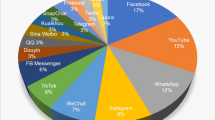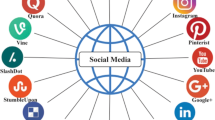Abstract
The widespread use of online social network (OSN) and the often-increasing volume of information provided by their users have motivated both corporate and scientific researchers to investigate how certain systems can be manipulated. According to recent findings, monitoring and evaluating the influence of OSN users has significant applications in the fields of health, economics, education, politics, entertainment, and other fields. The propagation model has an impact on a centrality measure’s capacity to show a node’s ability to disseminate influence. However, certain modeling techniques, a centrality measure that performs well on wandering and un-weightiness networks may produce low performance. To improve prediction performance, new-centrality measures and combined centrality measures are proposed employing linear combinations of centrality metrics.
Access this chapter
Tax calculation will be finalised at checkout
Purchases are for personal use only
Similar content being viewed by others
References
Backaler J (2018) Business to consumer (B2C) influencer marketing landscape. In: Digital influence. Springer, pp 55–68
Topirceanu A, Udrescu M, Marculescu R (2018) Weighted betweenness preferential attachment: a new mechanism explaining social network formation and evolution. Sci Rep 8(1):10871
Pálovics R, Benczúr AA (2015) Temporal influence over the Last.fm social network. In: Proceedings of the IEEE/ACM international conference on advances in social network analysis and mining, vol 5, no 1
Majumdar A, Saha D, Dasgupta P (2015) An analytical method to identify social ambassadors for a mobile service provider’s brand page on Facebook. In: Applications and innovations in mobile computing (AIMoC), 2015. IEEE, pp 117–123
Ponchai W, Watanapa B, Suriyathumrongkul K (2015) Finding characteristics of influencer in social network using association rule mining. In: Proceedings of the 10th international conference on e-business (iNCEB2015)
Magno F, Cassia F (2018) The impact of social media influencers in tourism. Anatolia 2018:1–3
Weeks BE, Ardèvol-Abreu A, Gil de Zúñiga H (2017) Online influence? Social media use, opinion leadership, and political persuasion. Int J Pub Opin Res 29(2):214–239
Zhou J, Liu F, Zhou H (2018) Understanding health food messages on Twitter for health literacy promotion. Perspect Pub Health 138(3):173–179
Riquelme F, González-Cantergiani P (2016) Measuring user influence on Twitter: a survey. Inf Process Manag 52(5):949–975
Deborah A, Michela A, Anna C (2019) How to quantify social media influencers: an empirical application at the Teatro alla Scala. Heliyon 5(5):e01677
Jain S, Sinha A (2021) Identification of influential users on Twitter: a novel weighted correlated influence measure for Covid-19. Chaos Solitons Fractals 139:110037
Khan HU, Nasir S, Nasim K, Shabbir D, Mahmood A (2021) Twitter trends: a ranking algorithm analysis on real time data. Expert Syst Appl 164:113990
Zhang H, Nguyen DT, Das S, Zhang H, Thai MT (2016), Least Cost Influence Maximization Across Multiple Social Networks, IEEE/ACM Trans Networking, https://doi.org/10.1109/TNET.2015.2394793
Romero DM, Galuba W, Asur S, Huberman BA (2011) Influence and passivity in social media. In: Joint European conference on machine learning and knowledge discovery in databases. Springer, pp 18–33
Bakshy E, Hofman JM, Mason WA, Watts DJ (2011) Everyone’s an influencer: quantifying influence on twitter. In: Proceedings of the fourth ACM international conference on Web search and data mining. ACM, pp 65–74
Gong M, Song C, Duan C, Ma L (2016) An Efficient Memetic Algorithm for Influence Maximization in Social Networks, IEEE Comput Intell Mag 11(3):22–33, https://doi.org/10.1109/MCI.2016.2572538
Wang N, Sun Q, Zhou Y, Shen S (2016) A Study on influential user identification in online social networks, Chinese Journal of Electronics, The Institution of Engineering and Technology. https://doi.org/10.1049/cje.2016.05.012
Weitzel L, Quaresma P, de Oliveira JPM (2012) Measuring node importance on twitter microblogging. In: Proceedings of the 2nd international conference on web intelligence, mining and semantics. ACM, no 11
Tong G, Wu W, Tang S, Du DZ (2017) Adaptive influence maximization in dynamic social networks, IEEE ACM Trans. Network, https://doi.org/10.1109/TNET.2016.2563397
Yamaguchi Y, Takahashi T, Amagasa T, Kitagawa H (2010) Turank: Twitter user ranking based on user-tweet graph analysis. In: International conference on web information systems engineering. Springer, pp 240–253
Zhao Q, Lu H, Gan Z, Ma X (2015) A K-shell decomposition based algorithm for influence maximization. In: Cimiano P, Frasincar F, Houben GJ, Schwabe D (eds) Engineering the web in the big data era. ICWE 2015. Lecture notes in computer science, vol 9114. Springer
Zhao N, Bao J, Chen N (2020) Ranking influential nodes in complex networks with information entropy method. Complexity 2020(5903798):15
Rani R, Bhatia V (2017) An efficient influence based label propagation algorithm for clustering large graphs, INFOCOM, https://doi.org/10.1109/ICTUS.2017.8286044
Rezaie B, Zahedi M, Mashayekhi H (2020) Measuring time-sensitive user influence in Twitter. Knowl Inf Syst 62:3481–3508
De Salve A, Mori P, Guidi B, Ricci L, Pietro RD (2021) Predicting influential users in online social network groups. ACM Trans Knowl Discov Data 15(35):1–50
Khan A, Sohail A, Zahoora U, Qureshi AS (2020) A survey of the recent architectures of deep convolutional neural networks. Artif Intell Rev 1–62
Tashiro S, Nakamura Y, Matsuda K, Matsuoka M (2016) Application of convolutional neural network to prediction of temperature distribution in data centers. In: 2016 IEEE 9th international conference on cloud computing (CLOUD), pp 656–661. https://doi.org/10.1109/CLOUD.2016.0092
Thaduri A, Polepally V, Vodithala S (2021) Traffic accident prediction based on CNN model. In: 2021 5th International conference on intelligent computing and control systems (ICICCS), pp 1590–1594. https://doi.org/10.1109/ICICCS51141.2021.9432224
Kavitha D, Hebbar R, Vinod PV, Harsheetha MP, Jyothi L, Madhu SH (2018) CNN based technique for systematic classification of field photographs. In: 2018 International conference on design innovations for 3Cs compute communicate control (ICDI3C), pp 59–63. https://doi.org/10.1109/ICDI3C.2018.00021
Cuzzocrea A, Leung CK, Deng D, Mai JJ, Jiang F, Fadda E (2020) A combined deep-learning and transfer-learning approach for supporting social influence prediction. Procedia Comput Sci 177:170–177
Abu-Salih B, Chan KY, Al-Kadi O et al (2020) Time-aware domain-based social influence prediction. J Big Data 7:10. https://doi.org/10.1186/s40537-020-0283-3
Author information
Authors and Affiliations
Corresponding author
Editor information
Editors and Affiliations
Rights and permissions
Copyright information
© 2023 The Author(s), under exclusive license to Springer Nature Singapore Pte Ltd.
About this paper
Cite this paper
Jothi, P., Padmapriya, R. (2023). An Influential User Prediction in Social Network Using Centrality Measures and Deep Learning Method. In: Khanna, A., Polkowski, Z., Castillo, O. (eds) Proceedings of Data Analytics and Management . Lecture Notes in Networks and Systems, vol 572. Springer, Singapore. https://doi.org/10.1007/978-981-19-7615-5_66
Download citation
DOI: https://doi.org/10.1007/978-981-19-7615-5_66
Published:
Publisher Name: Springer, Singapore
Print ISBN: 978-981-19-7614-8
Online ISBN: 978-981-19-7615-5
eBook Packages: Intelligent Technologies and RoboticsIntelligent Technologies and Robotics (R0)




